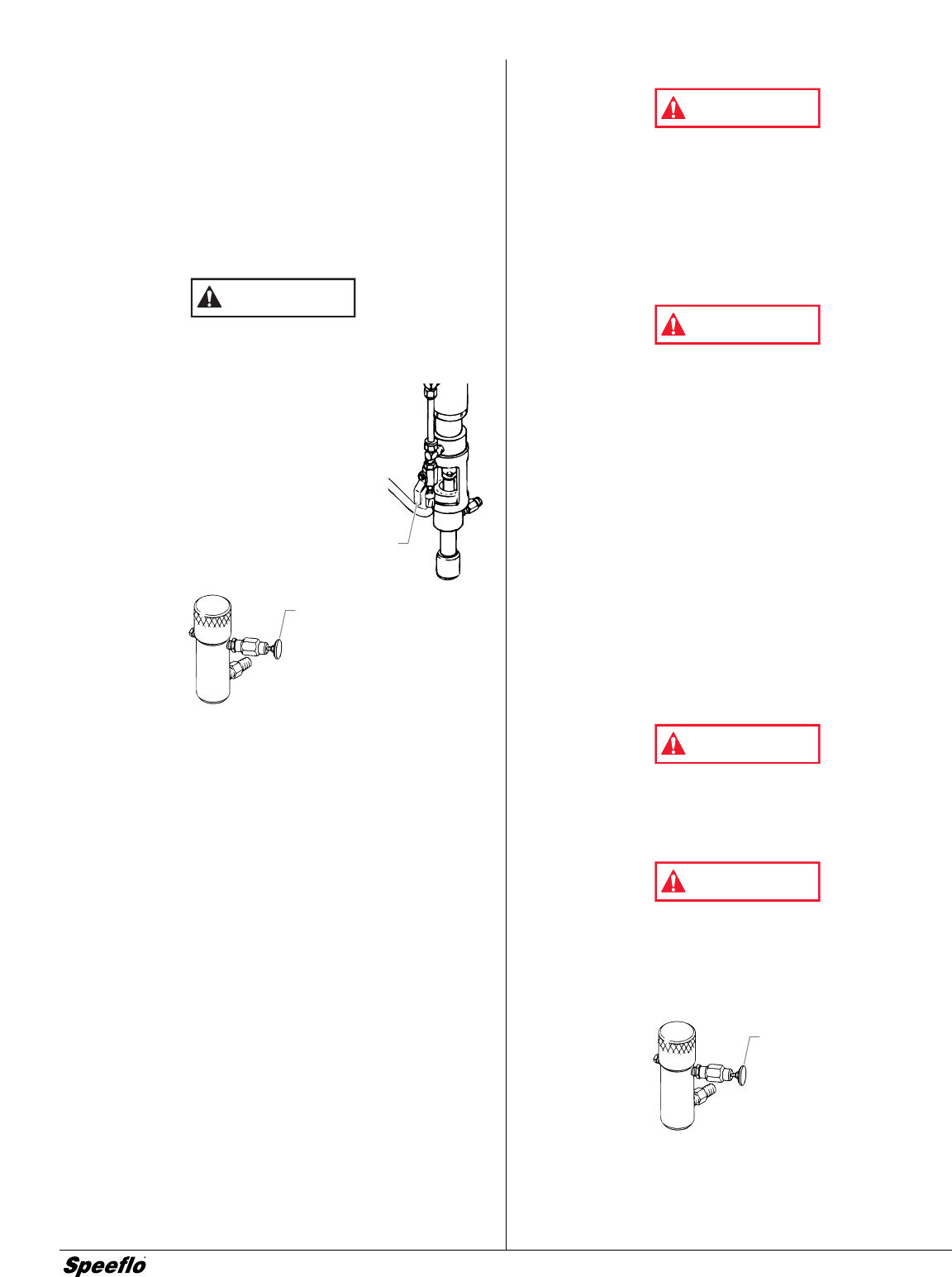
6 © Titan Tool Inc. All rights reserved.
Startup
1. Areas must be well ventilated to prevent hazardous
operation with volatile solvents or exhaust fumes.
2. Before starting the unit. check oil levels.
a. The hydraulic fluid level should read "Full" on the dipstick.
CHECK IT REGULARLY. See “Hydraulic System” in the
Maintenance section of this manual for changing or adding
hydraulic fluid. Do not overfill. Use only Speeflo Coolflo™
Hydraulic Fluid (P/N 430-361).
b. The gasoline engine oil level is determined by the
manufacturer. Check the manufacturer's service manual
supplied.
Use of Speeflo's Coolflo™ Hydraulic Fluid is mandatory in
the PowrLiner hydraulic system. Do not use any other
hydraulic fluid. Use of any other hydraulic fluid may
seriously damage hydraulic system and will void warranty.
3. Open the orange handle hydraulic
shut-off valve located on the
hydraulic pressure hose. Handle
should be in line with hose. The
figure below shows the handle in
the open position.
4. Turn the pressure control knob
counterclockwise (as viewed from
top) to its lowest pressure setting.
5. Open the pressure bleed valve by
turning it counterclockwise. This
relieves pressure.
a. Your new sprayer was tested at the factory with mineral
spirits. You must clean the system before spraying to
avoid contamination of the sprayed material.
If you are spraying a water based latex, flush with warm,
soapy water followed by a clean water rinse. If you are
using any other coating, flush with warm, soapy water
followed by a solvent. Check with the material
manufacturer for a compatible solvent. Place syphon
tube assembly into proper solvent or water.
b. Place waste container below bleed line.
c. Start engine or electric motor. Turn the pressure control
knob clockwise (increasing pressure) until pump cycles
evenly and solvent flows freely from bleed line.
d. Close the pressure bleed valve by turning it clockwise.
This allows the system to pressurize. Hold the gun
trigger open, without spray tip attached, until the fluid
flows smoothly.
6. Repeat above starting procedure with paint material. Lock
gun trigger and attach spray tip. Refer to the spray gun’s
Technical Data Sheet or Owner's Manual for tip installation
and selection of the proper tip size.
7. Test spray pattern. Operate the pump at the lowest hydraulic
pressure that provides good atomization. See the the
Troubleshooting section in this manual if you are not getting
the proper pattern.
8. Operating pressure is adjustable from 400 to 3300 psi (228
bar) by turning the pressure control knob clockwise. Do
not turn the knob clockwise more than necessary to
provide satisfactory atomization. Excess pressure wears
out spray tips.
9. When restarting the unit, reduce the pressure at the
pressure control knob and the pressure bleed valve.
Cleanup
Special cleanup instructions for use with flammable
solvents:
• Always flush spray gun preferably outside.
• If collecting flushed solvents in a one gallon metal
container, place it into an empty five gallon metal container,
then flush solvents.
• Area must be free of flammable vapors.
• Follow all cleanup instructions.
Pressure Relief Procedure
Always reduce pressure when you are cleaning a clogged
tip, changing a tip, servicing any part of the system, or
shutting down. Follow the steps below:
1. Engage the gun trigger lock.
2. Shut off the power source.
3. Close the orange handle hydraulic shut-off valve on the
hydraulic pressure hose.
4. Open the pressure bleed valve by turning it
counterclockwise at least three full turns.
5. Disengage the gun trigger lock and hold trigger open until
flow of material stops.
6. Be certain to hold a metal part of the gun firmly to the side
of a grounded metal container.
Cleaning a Clogged Tip
1. Follow the “Pressure Relief Procedure” above.
2. If tip clogs, rotate tip handle 180° until arrow on handle is
facing the opposite of spray direction and clicks in reverse
position.
3. Trigger gun once so that the pressure can blow the clog
out. NEVER use the tip in the reverse position for more
than ONE trigger pull at a time. This procedure can be
repeated until the tip is free of clogging.
The flow from the spray tip is at very high pressure. Contact
with any body part may be dangerous. Do not place finger
on gun outlet. Do not point the gun at any person. Never
operate the spray gun without the proper tip guard.
Color Change/Clean Out
Use only compatible solvents when cleaning out oil based
enamels, lacquers, coal tar, and epoxies. Check with the
fluid manufacturer for the recommended solvent.
1. Reduce pressure by turning the pressure control knob and the
pressure bleed valve counterclockwise. Follow the “Pressure
Relief Procedure” above. The pressure bleed valve should be
turned counterclockwise at least three full turns.
2. Pull siphon tube out of material container.
3. Remove spray tip from gun. Hold the gun trigger open until
material flow stops.
4. Put the siphon tube into wash solvent or water as
applicable, and operate pump slowly at low pressure until
solvent flows freely from the bleed line.
Pressure
Bleed
Valve
WARNING
WARNING
WARNING
WARNING
Pressure
Bleed
Valve
Hydraulic
Shut-Off
Valve
CAUTION
